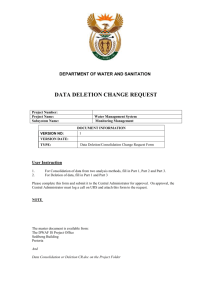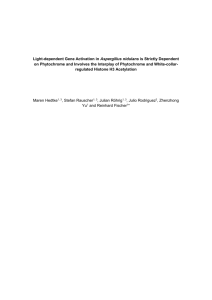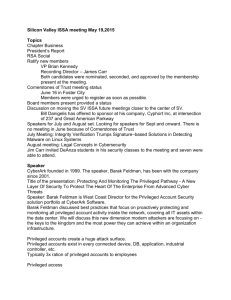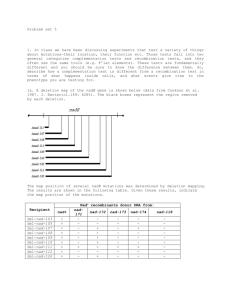Homework No
advertisement
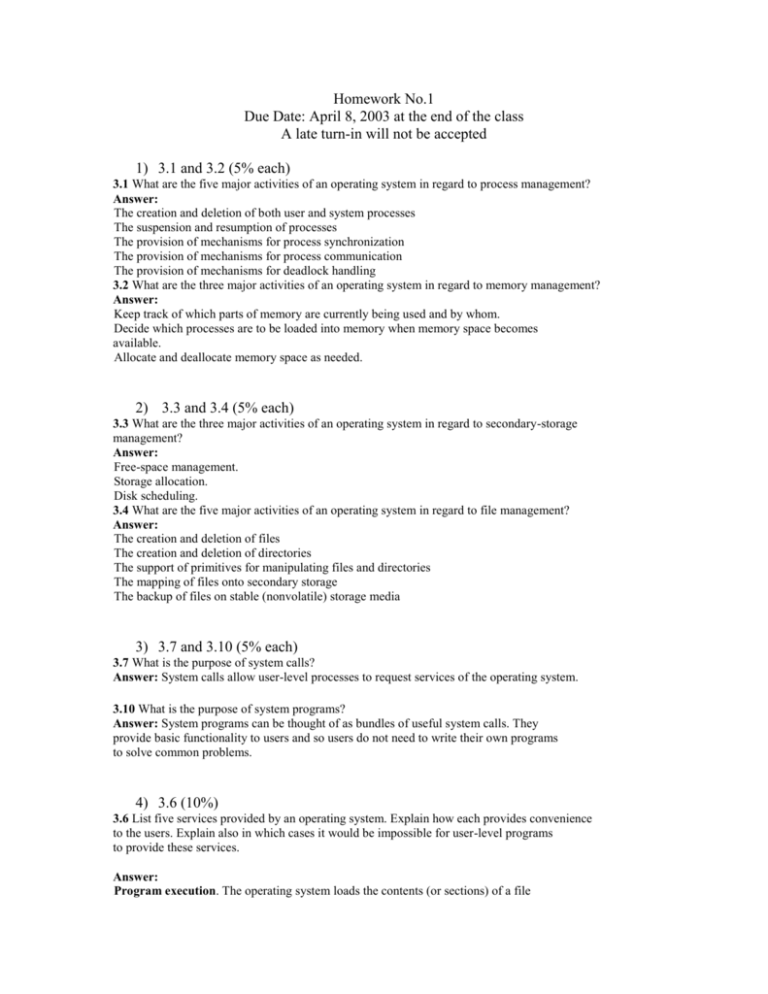
Homework No.1 Due Date: April 8, 2003 at the end of the class A late turn-in will not be accepted 1) 3.1 and 3.2 (5% each) 3.1 What are the five major activities of an operating system in regard to process management? Answer: The creation and deletion of both user and system processes The suspension and resumption of processes The provision of mechanisms for process synchronization The provision of mechanisms for process communication The provision of mechanisms for deadlock handling 3.2 What are the three major activities of an operating system in regard to memory management? Answer: Keep track of which parts of memory are currently being used and by whom. Decide which processes are to be loaded into memory when memory space becomes available. Allocate and deallocate memory space as needed. _ _ _ _ _ _ _ _ 2) 3.3 and 3.4 (5% each) 3.3 What are the three major activities of an operating system in regard to secondary-storage management? Answer: Free-space management. Storage allocation. Disk scheduling. 3.4 What are the five major activities of an operating system in regard to file management? Answer: The creation and deletion of files The creation and deletion of directories The support of primitives for manipulating files and directories The mapping of files onto secondary storage The backup of files on stable (nonvolatile) storage media _ _ _ _ _ _ _ _ 3) 3.7 and 3.10 (5% each) 3.7 What is the purpose of system calls? Answer: System calls allow user-level processes to request services of the operating system. 3.10 What is the purpose of system programs? Answer: System programs can be thought of as bundles of useful system calls. They provide basic functionality to users and so users do not need to write their own programs to solve common problems. 4) 3.6 (10%) 3.6 List five services provided by an operating system. Explain how each provides convenience to the users. Explain also in which cases it would be impossible for user-level programs to provide these services. Answer: Program execution. The operating system loads the contents (or sections) of a file _ into memory and begins its execution. A user-level program could not be trusted to properly allocate CPU time. I/O operations. Disks, tapes, serial lines, and other devices must be communicated with at a very low level. The user need only specify the device and the operation to perform on it, while the system converts that request into device- or controller-specific commands. User-level programs cannot be trusted to only access devices they should have access to and to only access them when they are otherwise unused. File-system manipulation. There are many details in file creation, deletion, allocation, and naming that users should not have to perform. Blocks of disk space are used by files and must be tracked. Deleting a file requires removing the name file information and freeing the allocated blocks. Protections must also be checked to assure proper file access. User programs could neither ensure adherence to protection methods nor be trusted to allocate only free blocks and deallocate blocks on file deletion. Communications. Message passing between systems requires messages be turned into packets of information, sent to the network controller, transmitted across a communications medium, and reassembled by the destination system. Packet ordering and data correction must take place. Again, user programs might not coordinate access to the network device, or they might receive packets destined for other processes. Error detection. Error detection occurs at both the hardware and software levels. At the hardware level, all data transfers must be inspected to ensure that data have not been corrupted in transit. All data on media must be checked to be sure they have not changed since they were written to the media. At the software level, media must be checked for data consistency; for instance, do the number of allocated and unallocated blocks of storage match the total number on the device. There, errors are frequently process-independent (for instance, the corruption of data on a disk), so there must be a global program(the operating system) that handles all types of errors. Also, by having errors processed by the operating system, processes need not contain code to catch and correct all the errors possible on a system. _ _ _ 5) 3.11 (5%) 3.11 What is the main advantage of the layered approach to system design? Answer: As in all cases of modular design, designing an operating system in a modular way has several advantages. The system is easier to debug and modify because changes affect only limited sections of the system rather than touching all sections of the operating system. Information is kept only where it is needed and is accessible only within a defined and restricted area, so any bugs affecting that data must be limited to a specific module or layer. 6) 2.2 (5%) 2.2 How does the distinction between monitor mode and usermode function as a rudimentary form of protection (security) system? Answer: By establishing a set of privileged instructions that can be executed only when in the monitor mode, the operating system is assured of controlling the entire system at all times. 7) 2.4 (5%) 2.4 For what types of operations is DMA useful? Explain your answer. Answer: DMA is useful for transferring large quantities of data between memory and devices. It eliminates the need for the CPU to be involved in the transfer, allowing the transfer to complete more quickly and the CPU to perform other tasks concurrently. 8) 2.5 (5%) 2.5 Which of the following instructions should be privileged? a. Set value of timer. b. Read the clock. c. Clear memory. d. Turn off interrupts. e. Switch from user to monitor mode. Answer: The following instructions should be privileged: a. Set value of timer. b. Clear memory. c. Turn off interrupts. d. Switch from user to monitor mode. 9) 2.6 (10%) 2.6 Some computer systems do not provide a privileged mode of operation in hardware. Consider whether it is possible to construct a secure operating system for these computers. Give arguments both that it is and that it is not possible. Answer: An operating system for a machine of this type would need to remain in control (or monitor mode) at all times. This could be accomplished by two methods: a. Software interpretation of all user programs (like some BASIC, APL, and LISP systems, for example). The software interpreter would provide, in software, what the hardware does not provide. b. Require meant that all programs be written in high-level languages so that all object code is compiler-produced. The compiler would generate (either in-line or by function calls) the protection checks that the hardware is missing. 10) 2.8 (10%) 2.8 Protecting the operating system is crucial to ensuring that the computer system operates correctly. Provision of this protection is the reason behind dual-mode operation, memory protection, and the timer. To allow maximum flexibility, however, we would also like to place minimal constraints on the user. The following is a list of operations that are normally protected. What is the minimal set of instructions that must be protected? Answer: The minimal set of instructions that must be protected are: a. Change to monitor mode. b. Read from monitor memory. c. Write into monitor memory. d. Turn off timer interrupt. 11) Download http://www.latech.edu/~box/p1/sample.tar and compile myshell sample code using make utility. Run myshell and find out the following myshell process’s information (text and Stack&data size may change at times, but just show at a snapshot). 20% a. Process ID (PID) b. c. d. e. Its parent process ID Text size (code size) Stack and Data size User ID

